|

On eBay Now...
Document 1821 Signed Mayors - Jacob Morton, Marshal at Washington Inauguration For Sale
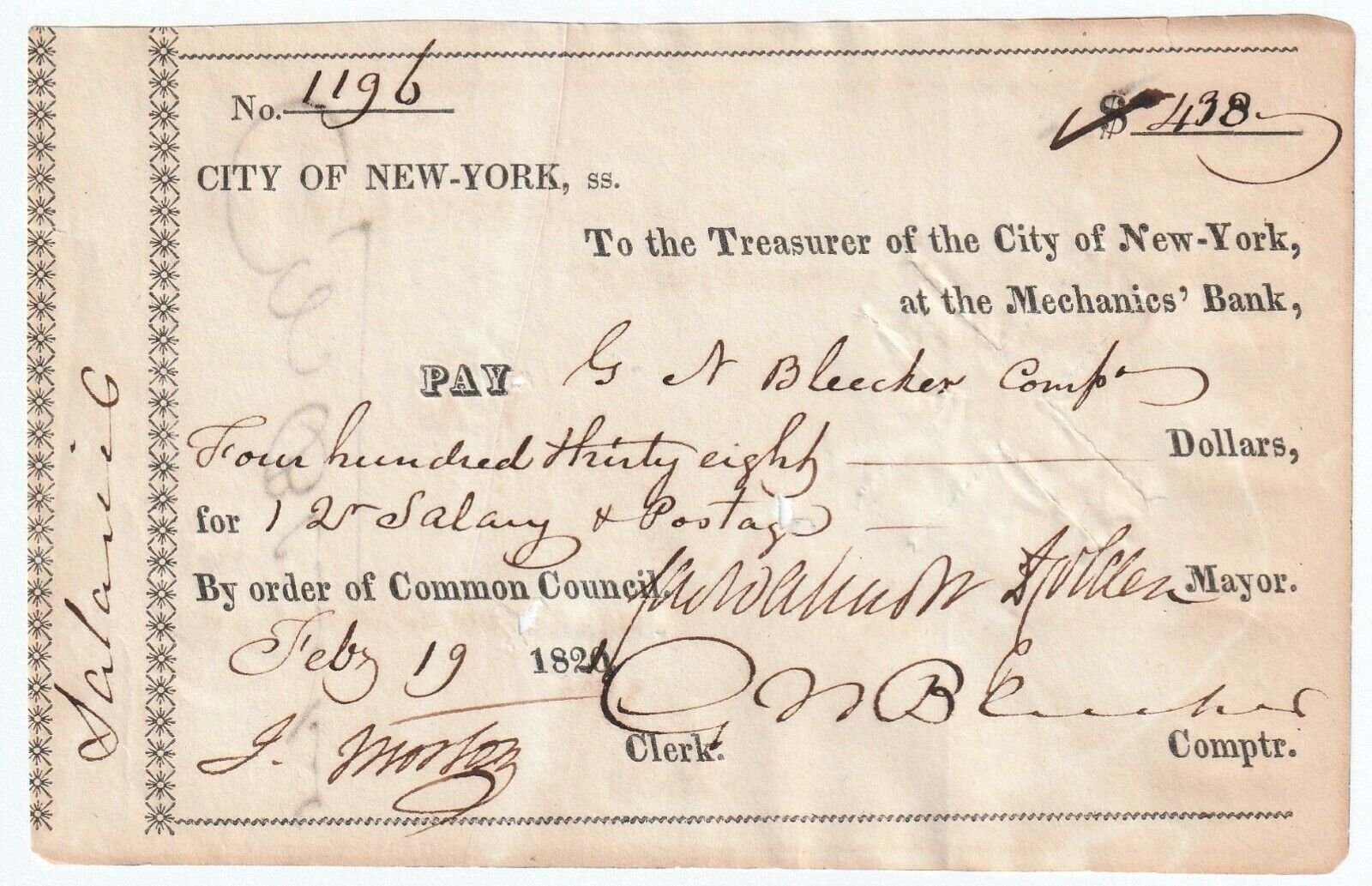
When you click on links to various merchants on this site and make a purchase, this can result in this site earning a commission. Affiliate programs and affiliations include, but are not limited to, the eBay Partner Network.

Document 1821 Signed Mayors - Jacob Morton, Marshal at Washington Inauguration:
$395.00
RARE Early American Document
Signed by Important People
General Jacob Morton - Marshal at George Washington\'s first Inauguration - He Got Bible used to swear in
Mayor Cadwallader D Colden
Comptroller Garrett N. Bleecker (signed twice)New York City Common Council1821
For offer, nice old pieces of ephemera! Fresh from a prominent estate.Vintage, Old, Original, Antique, NOTa Reproduction - Guaranteed !! Interesting document. To the Treasurer of the City of New York to pay for salary of Garrett Bleecker, comptroller. Signed by Mayor Cadwallader Colden and General Jacob Morton - Woshipful Master at St. John\'s Grand Masonic Lodge in New York - he was marshal at George Washington\'s first inauguration, and when a bible was needed to swear the president in, he got the bible from the lodge.In good to very good condition.Please seephotos. If you collect19thcentury Americana history, American documents, United States of America politics, manuscript writing, autographs, etc.this is a treasureyou will not see again!Add this to your image orpaper/ ephemera collection.Important genealogy research importance too. Combine shipping on multiple offer wins! 2747
Major-General Jacob Morton (1756–1836) was an American military officer, lawyer, and businessman.
BiographyMorton was born in 1756. He studied law at The College of New Jersey, the predecessor of Princeton University; however, Morton never practiced law.
Morton was the marshal for the First inauguration of George Washington. When it was found that no bible was available, Morton retrieved the Lodge Bible from St. John\'s Lodge where he was the Worshipful Master.
Morton served as New York City Comptroller from 1807 to 1808. Morton was also later clerk for the New York City Common Council.
Morton was an active Freemason, and was the Grand Master of Grand Lodge of New York from 1801–04.[1] The Grand Lodge of New York established an award named for Morton, known as the \"Jacob Morton Award\", given to Masons or Masonic Organizations that have demonstrated exceptional voluntary service to their community.[citation needed] In 1796, Jacob Morton was listed as the presiding officer of Ancient Encampment, Knights Templar (New York City), in its first published list of officers. He remained in that office until 1810, when all traces of the encampment were lost. In 1815, the Grand Encampment of Knights Templar of New York was created. On August 16, 1823, the Grand Encampment issued a warrant to Morton Encampment No. 4 (now Morton Commandery No. 4), which was named in honor of General Morton.[2]
Morton as promoted to brigadier-general in 1804. The Brigade he commanded was known as \"Morton\'s Brigade of Artillery,\" which was the precursor for the Seventh Regiment of New York.[3]
As Major-General, Morton led the New York Militia during the War of 1812.[4]Major General New York Militia. Morton was born into a wealthy New York City family and attended the College of New Jersey, now Princeton where he studied law and received a Master\'s Degree in 1782. In 1786 he received his first commission in the New York State militia and was on duty as the Parade Grand Marshal at the first inauguration of President Washington. In 1795 he was elected a member of the General Assembly, in 1797 he became a judge of the City Court and in 1803 became an alderman. He also became the City Comptroller and City Inspector and in 1809 the Clerk of the Common Council. In 1804 he was promoted to Brigadier General of artillery in what would later become the Seventh Regiment of New York militia. He commanded the artillery of the Regiment during the War of 1812 and by 1815 was a Major General and commanding officer of the First Division of New York Militia. He was a man of ability and distinction born to wealth and distinction. He was considered one of the leading young men in New York City at the close of the Revolutionary War. He lived at nine State street in one of the finest homes in the city and his home was considered one of the centers of entertainment in New York, including holding a reception and ball for Lafayette who visited New York in 1824. In 1831 he commanded the military escort at President Monroe\'s funeral. He died of exposure after participating in a parade at the end of November 1837. At the time of his death he had been a member of the New York militia for over fifty years.
Cadwallader David Colden (April 4, 1769 – February 7, 1834) was an American politician who served as the 54th Mayor of New York City and a U.S. Representative from New York.[1]
Early lifeColden was born at Spring Hill in Flushing, the family home, on April 4, 1769 in the Province of New York.[1] He was the son of David Colden and Ann Alice (née Willett) Colden. He was the brother of Alice Christy Colden, Maria Colden, who married Josiah Ogden Hoffman, Elizabeth Colden, who married Edward Laight, and Catherine Colden, who married Thomas Cooper.
He was the grandson of Alice (née Chrystie) Colden and Cadwallader Colden (1688–1776), who served as the Governor of the Province of New York several times in the 1750s and 1770s.[2]
He was taught by a private tutor, and then provided a classical education in Jamaica, New York and in London. After returning to the United States in 1785, he studied law, and was admitted to the bar in 1791.[1]
CareerColden first practiced law in New York City, then moved to Poughkeepsie, New York in 1793. He returned to New York in 1796 and from 1798 to 1801, he was Assistant Attorney General for the First District, comprising Suffolk, Queens, Kings, Richmond and Westchester counties. From 1810 to 1811, he was District Attorney of the First District, comprising the above-mentioned counties and New York County.[1]
Colden was an active Freemason. He was the Senior Grand Warden of the Grand Lodge of New York in 1801-1805 and 1810–1819.[3]
He became a Colonel of Volunteers in the War of 1812. Despite having owned slaves, in 1815 he became president of the New York Manumission Society, established in 1785 to promote the abolition of slavery in the state.[4] He oversaw the rebuilding of the Society\'s African Free School in New York City. Later historians cited the energetic aid of Colden, Peter A. Jay, William Jay, Governor Daniel D. Tompkins, and others in influencing the New York legislature to set the date of July 4, 1827, for the abolition of slavery in the state.
Colden was also a member of the New York State Assembly in 1818, and the 54th Mayor of New York City from 1818 to 1821, appointed by Governor DeWitt Clinton. He successfully contested the election of Peter Sharpe to the 17th United States Congress and served from December 12, 1821, to March 3, 1823. He was a member of the New York State Senate (1st District) from 1825 to 1827, when he resigned.[2]
After his resignation from the State Senate, he moved to Jersey City, New Jersey, where he devoted much of his time to the completion of the Morris Canal.[1]
Literary accomplishmentsA proponent of a national canal system, in 1825 Colden was commissioned by the Common Council of New York City, during the last days of the construction of the Erie Canal,[5] to write his Memoir, Prepared at the Request of a Committee of the Common Council of the City of New York, and Presented to the Mayor of the City, at the Celebration of the Completion of the New York Canals. The work and its Appendix contain period lithographs of the canal construction and highlights of the \"Grand Canal Celebration\" at New York City.[6]
Personal lifeOn April 8, 1793,[7][8] Colden was married to Maria Provoost (1770–1837), the daughter of Rt. Rev. Dr. Samuel Provoost, 1st Bishop of New York and Maria Bousefield Provoost.[9][10] Together, they were the parents of:
David Cadwallader Colden (1797–1850), who married Francis Wilkes (1796–1877),[11] daughter of banker Charles Wilkes and sister of Rear Admiral Charles Wilkes.[12]Colden died in Jersey City, in 1834. His body was removed in 1843 from an interment in New Jersey to a receiving vault in Trinity Church Cemetery in upper Manhattan in New York City.[1] He was removed in 1845 to a prominent spot in the cemetery\'s Easterly Division, overlooking the then rural intersection of the Bloomingdale Road (now Broadway) at West 153rd Street. By 1869, preparations to widen Broadway where the road cut through the cemetery caused Colden to be removed to another plot. His inconspicuous plot in the cemetery\'s Westerly Division was essentially forgotten until a local historian rediscovered it in July 2011.The New York City Council is the lawmaking body of New York City. It has 51 members from 51 council districts throughout the five boroughs.
The council serves as a check against the mayor in a mayor-council government model, the performance of city agencies land use decisions, and legislating on a variety of other issues. It also has sole responsibility for approving the city budget. Members elected in or after 2010 are limited to two consecutive four-year terms in office but may run again after a four-year respite; however, members elected before 2010 may seek third successive terms.
The head of the city council is called the speaker. The current speaker is Adrienne Adams, a Democrat from the 28th district in Queens. The speaker sets the agenda and presides at city council meetings, and all proposed legislation is submitted through the Speaker\'s Office. Majority Leader Keith Powers leads the chamber\'s Democratic majority. Minority Leader Joe Borelli leads the five Republican council members.
As of 2021, the council has 36 committees and 3 subcommittees, with oversight of various functions of the city government. Each council member sits on at least three standing, select or subcommittees (listed below).[1] The standing committees meet at least once per month. The speaker of the council, the majority leader, and the minority leader are all ex officio members of every committee.
Council members are elected every four years. The exception is two consecutive two-year terms every twenty years to allow for redistricting after each national census (starting in 2001 and 2003 for the 2000 census and again in 2021 and 2023 for the 2020 census).[2]
SalaryCouncil Members currently receive $148,500 a year in base salary, which the council increased from $112,500 in early 2016.[4] Members receive no additional compensation for serving as a committee chairperson or other officer under the new salary raise.[citation needed]
LawFurther information: Law of New YorkThe New York City Charter is the fundamental law of the government of New York City including the council. The New York City Administrative Code is the codification of the laws promulgated by the council and is composed of 29 titles.[5][6] The regulations promulgated by city agencies pursuant to law are contained in the Rules of the City of New York in 71 titles.[7]
A local law has a status equivalent with a law enacted by the legislature (subject to certain exceptions and restrictions), and is superior to the older forms of municipal legislation such as ordinances, resolutions, rules and regulations.[8] Each local government must designate a newspaper of notice to publish or describe its laws.[9] The secretary of state is responsible for publishing local laws as a supplement to the Laws of New York (the \"session laws\" of the state), but they have not done so in recent years.[9] The New York City Charter, the New York City Administrative Code, and the Rules of the City of New York are published online by the New York Legal Publishing Corp. under contract with the New York City Law Department.[10]
HistoryThe history of the New York City Council can be traced to Dutch Colonial times when New York City was known as New Amsterdam. On February 2, 1653, the town of New Amsterdam, founded on the southern tip of Manhattan Island in 1625, was incorporated as a city under a charter issued by the Dutch West India Company. A Council of Legislators sat as the local lawmaking body and as a court of inferior jurisdiction. During the 18th and 19th centuries the local legislature was called the Common Council and then the Board of Aldermen. In 1898 the amalgamation charter of the City of Greater New York renamed and revamped the council and added a New York City Board of Estimate with certain administrative and financial powers. After a number of changes through the ensuing years, the present Council was born in 1938 under a new charter which instituted the council as the sole legislative body and the New York City Board of Estimate as the chief administrative body. Certain functions of the council, however, remained subject to the approval of the board.
In 1938, a system of proportional representation known as single transferable vote was adopted; a fixed quota of 75,000 votes was set, so that the size of the council fluctuated with voter turnout.[11] The term was extended to four years in 1945 to coincide with the term of the mayor. Proportional representation was abolished in 1947, largely from pressure from Democrats, who played on fears of Communist council members being elected (two already had).[12] It was replaced by a system of electing one Council Member from each New York State Senate district within the city. The Charter also provided for the election of two Council Members-at-large from each of the five boroughs. In June 1983, however, a federal court ruled that the 10 at-large seats violated the United States Constitution\'s one-person, one-vote mandate.[13]
In 1989, the Supreme Court ruled that the Board of Estimate also violated the one-person, one-vote mandate. In response, the new Charter abolished the Board of Estimate and provided for the redrawing of the council district lines to increase minority representation on the council. It also increased the number of Council Members from 35 to 51. The council was then granted full power over the municipal budget, as well as authority over zoning, land use and franchises. In 1993 the New York City Council voted to rename the position of president of the city council to the Public Advocate. As the presiding officer, the Public Advocate was an ex officio member of all committees in the council, and in that capacity had the right to introduce and co-sponsor legislation.[14] However the city charter revision of 2002 transferred the duties of presiding officer from the Public Advocate to the Council Speaker; the Public Advocate remains a non-voting member of the council.[15]
Term limitsA two-term limit was imposed on city council members and citywide elected officials in a 1993 referendum. The movement to introduce term limits was led by Ronald Lauder, a cosmetics heir. In 1996, voters turned down a council proposal to extend term limits. Lauder spent $4 million on the two referenda.
However, in 2008, under pressure from Mayor Michael Bloomberg (who, like many Council members, was facing the end of his two-term limit at that time), the council voted 29–22 to extend the limit to three terms; the council also defeated (by a vote of 22–28, with one abstention) a proposal to submit the issue to public referendum.[16]
Legal challenges to the extension of term limits failed in federal court. The original decision by Judge Charles Sifton of the United States District Court for the Eastern District of New York (Long Island, Brooklyn, Queens and Staten Island) was upheld by a three-judge panel of the United States Court of Appeals for the Second Circuit (Vermont, Connecticut and New York), and a proposal in the New York State Legislature to override the extension was not passed.[17][18][19]
Voters voted to reinstate the two-term limit law in another referendum in 2010.[20] However, according to The New York Times, incumbent members of the city council who were elected prior to the 2010 referendum “will still be allowed to run for a third term. People in office before 2010 were eligible for three terms.”[21]
Presiding officers since 1898Through several changes in title and duties, this person has been, together with the Mayor and City Comptroller, one of the three municipal officers directly elected by all of the city\'s voters, and also the person who—when the elected mayor resigns, dies, or otherwise loses the ability to serve—becomes acting mayor until the next special or regular election.[22]
Until 1989, these three officers, together with the five borough presidents, constituted the New York City Board of Estimate. Political campaigns have traditionally tried to balance their candidates for these three offices to appeal as wide a range of the city\'s political, geographical, social, ethnic and religious constituencies as possible (and, when possible, to both genders).
The Office of Comptroller of New York City, a position established in 1801, is the chief financial officer and chief auditor of the city agencies and their performance and spending. The Comptroller also reviews all city contracts, handles the settlement of litigation claims (amounting to $975 million in 2019), issues municipal bonds, and manages the city\'s very large pension funds ($240 billion in assets under management as of 2020).
The Comptroller is elected citywide to a four-year term, and can hold office for two consecutive terms. As of 2021, the Comptroller had a staff of 800 people, and a budget of over $100 million. If vacancies were to occur simultaneously in the offices of Mayor of New York City and New York City Public Advocate, the Comptroller would become Acting Mayor.
The current Comptroller is Democrat Brad Lander. He was elected in 2021
Duties and staffThe Comptroller is responsible for auditing the performance and finances of city agencies, making recommendations regarding proposed contracts, issuing reports on the state of the city economy, marketing and selling municipal bonds, and managing city debt.[2] The Comptroller also \"is the custodian and investment advisor to the Boards\" of the five pension funds of the city, which are collectively referred to as \"NYC Public Pension Funds\" or \"New York City pension funds\".[3][4][2][5][6][7] The funds collectively amounted to $240 billion in assets under management as of 2020, the fourth-largest public pension plan in the US.[4][2][5][7] The Comptroller\'s regulations are compiled in Title 44 of the New York City Rules.[8]
If vacancies should simultaneously occur in the offices of Mayor of New York City and New York City Public Advocate (formerly president of the city council or board of aldermen), the Comptroller would become Acting Mayor.[9] The Comptroller serves as a check on the mayor, and is arguably the second most important elected official in New York City after the mayor.[2]
As of 2021, the Comptroller had a staff of 800 people, and a budget of over $100 office was created as an appointive office in 1801 by the New York City Common Council.[10] On September 6, 1802, after a tie vote by the New York City Common Council Committee on whether to pass an ordinance for the appointment of a Comptroller with a salary of $1,500 ($27,000 in current dollar terms), the ordinance was adopted by the Recorder, John B Prevost, Esquire, casting a vote in favor.[11] Thirty years later, the Comptroller became head of the Department of Finance. In 1884 the office became elective,[12] and in 1938 the Comptroller became head of a separate, independent department of the City\'s government. No Republican has been elected Comptroller since 1938.[3]
The Comptroller served on the eight-member New York City Board of Estimate, created in 1873, until the Board was held unconstitutional in a unanimous decision by the US Supreme Court in 1989 in Board of Estimate of City of New York v. Morris.[13][14] The Board was composed of the Mayor of New York City, the Comptroller, and the president of the New York City Council, each of whom was elected citywide and had four votes, and the five Borough presidents, each having two votes, despite the differing population sizes of each borough.[14] That construct was held by the US Supreme Court to violate the principle of one person, one vote.[14][15] The Board of Estimate was then abolished.[14]
In fiscal year 2019, the Comptroller resolved 13,712 claims and lawsuits against New York City for $975 million.[16] The Comptroller also issued 61 audits and special reports on the effectiveness and service quality of city programs, as well as on financial issues, identifying actual and potential revenue and savings.[17]
The first inauguration of George Washington as the first president of the United States was held on Thursday, April 30, 1789 on the balcony of Federal Hall in New York City, New York. The inauguration was held nearly two months after the beginning of the first four-year term of George Washington as president. Chancellor of New York Robert Livingston administered the presidential oath of office. With this inauguration, the executive branch of the United States government officially began operations under the new frame of government established by the 1787 Constitution. The inauguration of John Adams as vice president was on April 21, 1789, when he assumed his duties as presiding officer of the United States Senate, this also remains the only scheduled inauguration to take place on a day that was neither January or March.Start of the first presidential termThe first presidential term started on March 4, 1789, the date set by the Congress of the Confederation for the beginning of operations of the federal government under the new U.S. Constitution.[1] However, logistical delays prevented the actual start of the operations of the Executive Branch on that day. On that date, the House of Representatives and the Senate convened for the first time, but both adjourned due to lack of a quorum.[2] As a result, the presidential electoral votes could not be counted or certified. On April 1, the House convened with a quorum present for the first time, and the representatives began their work, with the election of Frederick Muhlenberg as its Speaker. The Senate first achieved a quorum on April 6, and elected John Langdon as its president pro tempore. That same day, the House and Senate met in joint session and the electoral votes were counted. Washington and Adams were certified as having been elected president and vice president respectively.[3][4]
It was 5 p.m. at Mount Vernon on April 14, 1789, when Washington received official notification that he had been unanimously selected by the Electoral College to be the nation\'s first president. The letter had been sent by Senator John Langdon of New Hampshire, the first president pro tempore of the United States Senate, who had presided over the counting of the electoral votes. Washington replied immediately, and set off in the morning two days later,[5] accompanied by David Humphreys and a Mr. Thomson,[6] who was the Messenger appointed by the Senate, that delivered to General Washington the letter containing the news of his election.[7]
Washington\'s journey to New YorkOn his way to New York City, Washington received triumphal welcomes in almost every town he passed through. These included Alexandria, Georgetown, Maryland (now part of Washington D.C.), Baltimore and Havre de Grace. One of the places he spent the night was Spurrier\'s Tavern in Baltimore. Just after noon on April 20, Washington arrived to an elaborate welcome at Gray\'s Ferry in Philadelphia. On April 21, the Ladies of Trenton hosted his reception at Trenton.[8] On April 23 he took a small barge with 13 pilots through the Kill Van Kull tidal strait into the Upper New York Bay, and from there the city. A variety of boats surrounded him during the voyage, and Washington\'s approach was greeted by a series of cannon fire, first a thirteen gun salute by the Spanish warship Galveston, then by the North Carolina, and finally by other artillery.[6] Thousands had gathered on the waterfront to see him arrive.[9] Washington landed at Murray\'s Wharf (at the foot of Wall Street), where he was greeted by New York Governor George Clinton as well as other congressmen and citizens.[6] A plaque now marks the landing site.[10] They proceeded through the streets to what would be Washington\'s new official residence, 3 Cherry Street.[9]
Inauguration
Federal Hall, New York City, site of George Washington\'s first inauguration, April 30, 1789.Since nearly first light on April 30, 1789, a crowd of people had begun to gather around Washington\'s home, and at noon they made their way to Federal Hall by way of Queen Street and Great Dock (both now Pearl Street) and Broad Street.[6] Washington dressed in an American-made dark brown suit with white silk stockings and silver shoe buckles; he also wore a steel-hilted sword and dark red overcoat.[11]
Upon his arrival at Federal Hall, then the nation\'s capitol and the site where the 1st United States Congress met, Washington was formally introduced to the House and Senate, after which Vice President John Adams announced it was time for the inauguration (Adams had already assumed the office of Vice President on April 21, when he began presiding over the Senate sessions). Washington moved to the second-floor balcony. Chancellor of New York Robert Livingston, who had served on the Committee of Five which had drafted the Declaration of Independence, administered the presidential oath of office in view of throngs of people gathered on the streets.[12][13] The Bible used in the ceremony was from St. John\'s Lodge No. 1, A.Y.M.,[14] and due to haste, it was opened at random to Genesis 49:13 (\"Zebulun shall dwell at the haven of the sea; and he shall be for an haven of ships; and his border shall be unto Zidon\").[11] Afterwards, Livingston shouted \"Long live George Washington, President of the United States!\" [15] to the crowd, which was replied to with cheers and a 13-gun salute.[16] The first inaugural address was subsequently delivered by Washington in the Senate chamber,[6] running 1419 words in length.[11] At this time there were no inaugural balls on the day of the ceremony, though a week later, on May 7, a ball was held in New York City to honor the first President.[17]
Three days before George Washington took the oath of office as the first president of the United States, Congress passed the following resolution: Resolved, That after the oath shall have been administered to the President, he, attended by the Vice President and members of the Senate and House of Representatives, shall proceed to St. Paul’s Chapel, to hear divine service.[18] Accordingly, the Right Rev. Samuel Provoost (1742–1815), newly appointed chaplain of the United States Senate and first Episcopal bishop of New York, officiated at a service in St. Paul\'s Chapel on April 30, 1789, immediately following Washington’s inauguration, with the newly inaugurated President and members of Congress present.[19]
In popular cultureThe inauguration is depicted in an episode of the 2008 HBO miniseries, John Adams, although Robert Livingston is erroneously depicted as shouting \"God bless George Washington!\" at the conclusion of the ceremony, rather than \"Long live George Washington!\"This event, its location, and date of April 30, are given particular significance in Metal Gear Solid 2: Sons of Liberty.St. John\'s Lodge No. 1 A.Y.M. in New York City, United States, is the oldest operating Masonic Lodge under the jurisdiction of the Grand Lodge of New York Free and Accepted Masons. The lodge was originally warranted as St. John\'s Lodge No. 2 on December 7, 1757 by George Harison, Esq. of the Provincial Grand Lodge of New York under the Grand Lodge of England (Moderns).[1][2]
HistoryThe lodge originally met on Ann Street in New York City. In 1770, a fire destroyed St. John\'s Lodge room, along with their lodge jewels and furniture. A new set of by-laws was adopted in 1773 and was signed by 70 members of the lodge. The lodge purchased a new altar bible in November 1770 which was used in the first Presidential Inauguration and is now known as the George Washington Inaugural Bible.[3][4][5][6]
At the start of the American Revolutionary War in 1775, the members of St. John’s Lodge who supported the Colonies’ independence seized the lodge’s warrant, and fled New York City. These exiled members held gatherings at the Fishkill Supply Depot in Fishkill, NY until the end of the war in 1783, when they returned to New York City with the warrant, while many Masons who supported the British fled to Canada.[7]
In 1789, St. John’s was acknowledged as the oldest Masonic lodge in New York State, and was designated as Number 1. A new charter was then conveyed to St. John’s Lodge, under which charter the lodge is still working.[8]
Notable membersEdward Antill – Lt. Colonel in the Revolutionary WarAbraham Baldwin – First president of the University of GeorgiaJoshua Bloomer – First graduate of King\'s College (now known as Columbia University)Ebenezer Foote – Major in the Revolutionary WarJacob Morton – Marshal for the First inauguration of George WashingtonJohn Ramage – Miniature artist and Second Lieutenant in the Revolutionary WarGeorge Washington (February 22, 1732[b] – December 14, 1799) was an American soldier, statesman, and Founding Father who served as the first president of the United States from 1789 to 1797. Appointed by the Continental Congress as commander of the Continental Army, Washington led the Patriot forces to victory in the American Revolutionary War, and presided at the Constitutional Convention of 1787, which established the Constitution of the United States and a federal government. Washington has been called the \"Father of the Nation\" for his manifold leadership in the formative days of the country.[10]
Washington\'s first public office was serving as official Surveyor of Culpeper County, Virginia from 1749 to 1750. Subsequently, he received his initial military training (as well as a command with the Virginia Regiment) during the French and Indian War. He was later elected to the Virginia House of Burgesses and was named a delegate to the Continental Congress. Here he was appointed Commanding General of the Continental Army. With this title, he commanded American forces (allied with France) in the defeat and surrender of the British at the Siege of Yorktown during the American Revolutionary War. He resigned his commission after the Treaty of Paris was signed in 1783.
Washington played an indispensable role in adopting and ratifying the Constitution of the United States. He was then twice elected president by the Electoral College unanimously. As president, he implemented a strong, well-financed national government while remaining impartial in a fierce rivalry between cabinet members Thomas Jefferson and Alexander Hamilton. During the French Revolution, he proclaimed a policy of neutrality while sanctioning the Jay Treaty. He set enduring precedents for the office of president, including the title \"Mr. President\", and his Farewell Address is widely regarded as a pre-eminent statement on republicanism.
Washington was a slaveowner who had a complicated relationship with slavery. Washington controlled a total of over 577 slaves at one time or another, who were forced to work on his farm and in his houses, including the White House. As president, he signed laws passed by Congress that both protected and curtailed slavery. His will said that one of his slaves, William Lee, should be freed upon his death, and that the other 123 slaves must work for his wife and be freed on her death. She freed them during her lifetime to remove the incentive to hasten her death.[11][12]
He endeavored to assimilate Native Americans into the Anglo-American culture but fought indigenous resistance during instances of violent conflict. He was a member of the Anglican Church and the Freemasons, and he urged broad religious freedom in his roles as general and president. Upon his death, he was eulogized by Henry \"Light-Horse Harry\" Lee as \"first in war, first in peace, and first in the hearts of his countrymen\".[13]
Washington has been memorialized by monuments, a federal holiday, various media, geographical locations, including the national capital, the State of Washington, stamps, and currency, and many scholars and polls rank him among the greatest U.S. presidents. In 1976 Washington was posthumously promoted to the rank of General of the Armies of the United States.

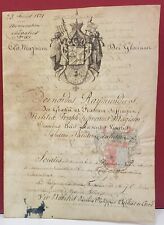
1821 Old Award Ceremony Document With Metal $100.00
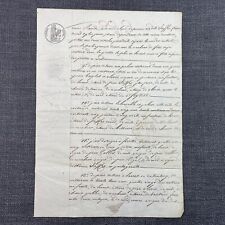
Antique Document 1821 French Will and Testament Embossed Timbre Royal Seal $50.00
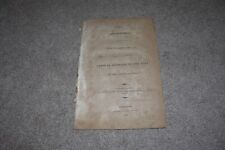
1821 Documents Increase Navy of United States Government Document $9.95

Document 1821 Signed Mayors - Jacob Morton, Marshal at Washington Inauguration $395.00
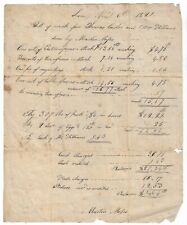
1821 Martin Moses Silversmith Handwritten Receipt Lenox MA Antique Mass Silver $40.00
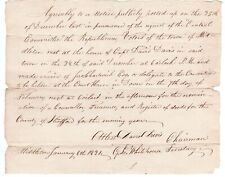
1821 Middleton, CT Election of Republican Delegate Notice Document $10.00
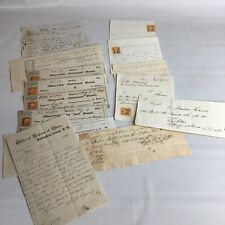
Lot of 9 documents 1821-61 Billhead Promissory P.O. Warrant Burning house Misc $48.30

RARE “Father of Probation” John Augustus Signed Document Dated 1821 $1119.99
|